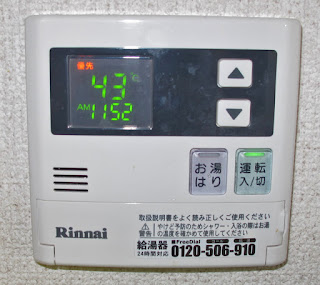HOUSING – THINGS TO CONSIDER
A big selling point for any home in Japan is "Walking Time
to the nearest train station" which will always be posted with a home
description.
When renting a house/apartment besides a security deposit, that matches one month of rent, it is very common to have an additional fee to the owner, a non-refundable "gift" matching the cost of a month of rent.
When renting a house/apartment besides a security deposit, that matches one month of rent, it is very common to have an additional fee to the owner, a non-refundable "gift" matching the cost of a month of rent.
Apartments and houses do NOT come with a refrigerator or
microwave and some don't even come with a stove (many home still have stoves
that use propane from tanks) --- all must be provided by you. They do not use in-sink
garbage disposals. There is no central heat. Many homes have permanently installed
space heaters in the main rooms but if not you need to get free standing
electric or kerosene heaters.

Wall mounted space heater

Electric Space Heater
Another common U.S. item not generally found in Japan is a
large oven. They sell cook-tops with a couple of burners on top and a small,
about one foot long by six inches high “oven” built in. Probably more properly
called a broiler. They are not big enough to cook a full chicken. I am not sure
if they are practical for baking but you would not be able to bake more than one
layer/pan of a cake at a time.

No oven - just a small broiler
Some houses have no direct access to the nearest road and you have to walk up 50-100 steps to get to the door (no other way). Some are on VERY narrow streets where delivery vans or ambulances would not fit.
Often when you buy/rent a house you have to participate in the neighborhood "association" where people take turns patrolling the neighborhood, picking up trash, etc.
Often when you buy/rent a house you have to participate in the neighborhood "association" where people take turns patrolling the neighborhood, picking up trash, etc.
BATHING
Japanese homes to not have a hot water tank, they use a localized “heat on demand” system, usually only hooked up to the kitchen faucet and shower room. The system is adjusted by a single control box, often mounted in the kitchen with a default setting for warm temperatures for kitchen use. When one desires to take a shower, they must remember to go to the kitchen and manually raise the temperature. After a predetermined time, the temperature will reset itself to the default. The system works good; water heats up rapidly and you don’t run out of hot water. Once again, another electricity saving device.
Water heater control
Showers – Unlike American bathrooms, the bathing room is separate from the toilet. What the American thinks of as the Shower Door, in the Japanese home, the Shower Door encloses both a shower area (NOT in the tub) and the tub.
The shower head itself, is attached to a flexible hose (many American home already have adapted this), with a mount high, for the standing user, and a mount low for the seated user. It is common for females to shower while seated on a small plastic stool.

Shower/bathtub
No comments:
Post a Comment